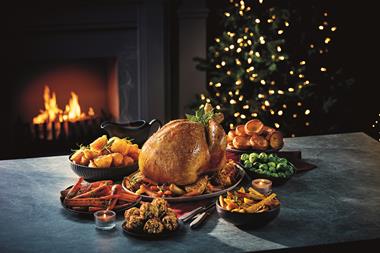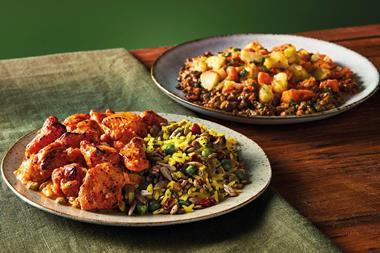L’Oréal is convinced skincare is a sleeping giant, especially for the male of the species says Liz Hamson
Geoff Skingsley is covered in a light dusting of shimmery brown Maybelline eye shadow. He reaches up to a shelf behind him to grab a lipstick. “You should try it again,” he urges, twisting it open to reveal a candy pink concoction. “It’s a very good product.”
He should know. He’s the MD of L’Oréal UK, whose brands include L’Oréal Paris, Garnier, Maybelline and salon professional brands - although to set the record straight he doesn’t actually wear the stuff. The smattering of eye shadow is what happens when the stiff compact abruptly and explosively yields to fingers prising it open too eagerly. It is an ironically apt image nonetheless.
After establishing itself as a leading name in women’s health and beauty, the £500m company is finally considering doing a bit more for the boys than just shampoo and a couple of unisex hair-styling products.
At L’Oréal’s UK head office in west London’s Hammersmith, Skingsley tells The Grocer why it is targeting the grocery sector to drive growth and what else the company has in the new product development pipeline. The L’Oréal stable ranges from the eponymous brand itself, which Skingsley describes as “the aspirational bridge to the luxury brands” to Laboratoire Garnier, which he says is cheaper and more irreverent though still based in science.
Women clearly think L’Oréal is worth it. Over the past four years, while the total health and beauty market has been growing by 7% a year and in grocery by 10%, L’Oréal has been growing by 13% and 20% respectively.
Skingsley says that it has worked hard to make more of a distinction between the brands so that there’s no cannibalisation of sales. But what really keeps it ahead of the competition is new ideas. “Our growth model depends on innovation - 18% of our business is from innovations and that’s a huge impetus to new product development. We constantly learn more about what women want in terms of the products and trends and we always over-invest in NPD.”
L’Oréal now has an 18% share of the total health and beauty market. Skingsley concedes there is still some way to go in grocery, where that figure is in the low teens, and blames the notional conflict between the limited amount of space a grocer can give health and beauty. But, he says, the situation is improving. “We want to increase its range in grocery, not least because grocers have shown more commitment to non-food, so we can increase our offer.”
Skingsley is also keen to introduce higher price-bracket products into grocery. Two months ago, it launched L’Oréal Couleur Expert, which he boasts is the first product that can change base colour and add tonal highlights.
He is confident that the “very leading edge product” will achieve a full listing by Christmas. But in a trading environment in which most health and beauty products retail at between £3.50 and £5.50, won’t consumers balk at the £9.70 price tag?
“People who worry there’s only one way to grow the business - by driving prices down - are wrong,” he responds emphatically. “We’ve had fantastic sales with this product and it shows that as long as you create a new, better service, you get customer satisfaction. It’s not a question of a budget to blow everyone else out of the water. It’s about education at the PoS.” And the retailers? “They know a good product opportunity when they see one,” he retorts. “But the approach of certain grocers to price is very value-driven and we are not spared that. If retailer views swamp other considerations like instore theatre, they’re missing a trick.”
The company has won an award for developing Tesco’s instore health and beauty offer at its flagship store in Warrington and worked closely with Asda. Skingsley emphasises the importance of working with retailers who understand grocery and health and beauty need to be handled very differently.
But, he adds drily, “some could go further in creating a more compelling environment and appealing to the functional and emotional needs of consumers”.
Compliance is another issue: “It’s never perfect. We have a battle to win the hearts and minds of the store managers. But there’s no question they have a difficult task.”
The ELDP players are going to have an even tougher task soon as L’Oréal intensifies its efforts to increase both the range and price of its products in the grocery sector. Skingsley is adamant, however, that if the product is right for the consumer then it will be right for the retailer. And on that score, he is totally confident that the company has identified the trends that will define the market next year.
In the short term, the company is focusing its npd efforts on the younger end of the hair colourings market. “We think there’s room for a daring colour offer,” explains Skingsley. It has also identified “tremendous opportunities” in skincare - particularly for men, though it is not prepared to rush into anything, he says. “If we want to get in, we have to have something different. It’s on the mid-horizon.”
In the US, meanwhile, there’s been a lot of talk about the company entering the ethnic haircare market and Skingsley confirms that it is also planning to launch a range in the UK. “We are working on a commercial model but it won’t be happening in the next three months,” he explains.
The challenges to L’Oréal’s business are mounting. Procter & Gamble recently bought Wella - a move,which Skingsley says certainly changes the landscape but is not going to make L’Oréal change its strategy. But little fazes the rugby fan and former amateur footballer. Certainly not the rumours that although there are substantial differences in the price of similar products, depending on the brand, there is little or no difference in the quality.
Skingsley shrugs: “There is some price positioning. But some women are prepared to pay more for certain brands. With Lancôme, it’s an assisted sale. With L’Oréal they get the codes of the luxury category and the combined benefits of the product and innovative packaging, but it’s self-service.”
Now he wants to introduce luxury products to grocery, will we see a £20 face cream? “If the product is right and has the ‘technology promise’, then, yes,” says Skingsley. For now, though,he is confident he can go to market with a £15 product. “Next year we’ll introduce more products at the upper price range. It’s an opportunity to make skincare a more serious part of the shop.”
Meanwhile, he has this message for retailers: “Don’t let health and beauty be marginalised by price obsession. The price message must not stifle innovation.”
Geoff Skingsley is covered in a light dusting of shimmery brown Maybelline eye shadow. He reaches up to a shelf behind him to grab a lipstick. “You should try it again,” he urges, twisting it open to reveal a candy pink concoction. “It’s a very good product.”
He should know. He’s the MD of L’Oréal UK, whose brands include L’Oréal Paris, Garnier, Maybelline and salon professional brands - although to set the record straight he doesn’t actually wear the stuff. The smattering of eye shadow is what happens when the stiff compact abruptly and explosively yields to fingers prising it open too eagerly. It is an ironically apt image nonetheless.
After establishing itself as a leading name in women’s health and beauty, the £500m company is finally considering doing a bit more for the boys than just shampoo and a couple of unisex hair-styling products.
At L’Oréal’s UK head office in west London’s Hammersmith, Skingsley tells The Grocer why it is targeting the grocery sector to drive growth and what else the company has in the new product development pipeline. The L’Oréal stable ranges from the eponymous brand itself, which Skingsley describes as “the aspirational bridge to the luxury brands” to Laboratoire Garnier, which he says is cheaper and more irreverent though still based in science.
Women clearly think L’Oréal is worth it. Over the past four years, while the total health and beauty market has been growing by 7% a year and in grocery by 10%, L’Oréal has been growing by 13% and 20% respectively.
Skingsley says that it has worked hard to make more of a distinction between the brands so that there’s no cannibalisation of sales. But what really keeps it ahead of the competition is new ideas. “Our growth model depends on innovation - 18% of our business is from innovations and that’s a huge impetus to new product development. We constantly learn more about what women want in terms of the products and trends and we always over-invest in NPD.”
L’Oréal now has an 18% share of the total health and beauty market. Skingsley concedes there is still some way to go in grocery, where that figure is in the low teens, and blames the notional conflict between the limited amount of space a grocer can give health and beauty. But, he says, the situation is improving. “We want to increase its range in grocery, not least because grocers have shown more commitment to non-food, so we can increase our offer.”
Skingsley is also keen to introduce higher price-bracket products into grocery. Two months ago, it launched L’Oréal Couleur Expert, which he boasts is the first product that can change base colour and add tonal highlights.
He is confident that the “very leading edge product” will achieve a full listing by Christmas. But in a trading environment in which most health and beauty products retail at between £3.50 and £5.50, won’t consumers balk at the £9.70 price tag?
“People who worry there’s only one way to grow the business - by driving prices down - are wrong,” he responds emphatically. “We’ve had fantastic sales with this product and it shows that as long as you create a new, better service, you get customer satisfaction. It’s not a question of a budget to blow everyone else out of the water. It’s about education at the PoS.” And the retailers? “They know a good product opportunity when they see one,” he retorts. “But the approach of certain grocers to price is very value-driven and we are not spared that. If retailer views swamp other considerations like instore theatre, they’re missing a trick.”
The company has won an award for developing Tesco’s instore health and beauty offer at its flagship store in Warrington and worked closely with Asda. Skingsley emphasises the importance of working with retailers who understand grocery and health and beauty need to be handled very differently.
But, he adds drily, “some could go further in creating a more compelling environment and appealing to the functional and emotional needs of consumers”.
Compliance is another issue: “It’s never perfect. We have a battle to win the hearts and minds of the store managers. But there’s no question they have a difficult task.”
The ELDP players are going to have an even tougher task soon as L’Oréal intensifies its efforts to increase both the range and price of its products in the grocery sector. Skingsley is adamant, however, that if the product is right for the consumer then it will be right for the retailer. And on that score, he is totally confident that the company has identified the trends that will define the market next year.
In the short term, the company is focusing its npd efforts on the younger end of the hair colourings market. “We think there’s room for a daring colour offer,” explains Skingsley. It has also identified “tremendous opportunities” in skincare - particularly for men, though it is not prepared to rush into anything, he says. “If we want to get in, we have to have something different. It’s on the mid-horizon.”
In the US, meanwhile, there’s been a lot of talk about the company entering the ethnic haircare market and Skingsley confirms that it is also planning to launch a range in the UK. “We are working on a commercial model but it won’t be happening in the next three months,” he explains.
The challenges to L’Oréal’s business are mounting. Procter & Gamble recently bought Wella - a move,which Skingsley says certainly changes the landscape but is not going to make L’Oréal change its strategy. But little fazes the rugby fan and former amateur footballer. Certainly not the rumours that although there are substantial differences in the price of similar products, depending on the brand, there is little or no difference in the quality.
Skingsley shrugs: “There is some price positioning. But some women are prepared to pay more for certain brands. With Lancôme, it’s an assisted sale. With L’Oréal they get the codes of the luxury category and the combined benefits of the product and innovative packaging, but it’s self-service.”
Now he wants to introduce luxury products to grocery, will we see a £20 face cream? “If the product is right and has the ‘technology promise’, then, yes,” says Skingsley. For now, though,he is confident he can go to market with a £15 product. “Next year we’ll introduce more products at the upper price range. It’s an opportunity to make skincare a more serious part of the shop.”
Meanwhile, he has this message for retailers: “Don’t let health and beauty be marginalised by price obsession. The price message must not stifle innovation.”













No comments yet